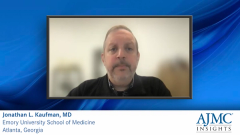
Improving Payer Education on RRMM Therapy
Professional experts offer suggestions on how payers can be further educated on RRMM treatment.
Episodes in this series

Joshua Richter, MD: I think myeloma is one of the toughest places to lay out educational efforts simply because the data evolve so quickly. I rounded this morning inpatient and ran into some of my leukemia colleagues, and they noted about how the backbone of their leukemia therapy for induction is still 7+3. Yes, there are additives to it, but the 7+3 backbone has not significantly changed in decades, whereas in myeloma therapy, we have seen a new approval every 3 to 6 months, as well as data of available therapies being updated all the time with newer insights on how to optimize strategies. I think if I were to approach the payers in terms of educational resources, I would make this an iterative process, proposing some type of educational slide deck and information and sending it to them. By the time it’s created, there are already flaws in that data that we know how to overcome, so I this is going to require an iterative and high-level interaction between all parties: payers, pharmacy, academia. There needs to be a regular interaction with everyone at the table to optimize patient outcomes while maintaining an insight into the economic burden it puts on the system at large.
There are number of processes that have been set up by pharmacy companies specifically to help work with the payers to minimize delays. There are some that are often referred to as quick start programs. A number of these exist between IMiDS [immunomodulatory drugs] and selinexor to make sure that, with parenteral therapies, the time to treatment is often much reduced. We have these drugs in stock and on formulary, but oral oncolytics have a process that may take 2 weeks or longer, so there are already setup pathways within the pharmacy companies to help expedite through the payers when there is more urgent need to start an oral oncolytic, often times being able to receive the oral therapy within 3 days.
Jonathan L. Kaufman, MD: When I think about what payers need to know most about myeloma, it’s that myeloma is a disease where, [since the development of proteasome inhibitors and IMiDS], survival has increased [and keeps increasing] dramatically over the past 20 years. I regularly see patients that I have taken care of for 10 years in my clinic. These patients are living a lot longer, but the reason is because of the medications that we have available. We need to recognize that the patients are living longer but not being cured. A patient with myeloma will need life-long benefits from their medication therapy. The type of thing I would want to know as a payer is asking when a patient is in remission. Are there factors that we can use to help decide when it’s OK to stop therapy and not be associated with worse outcomes? One of the things we are looking at is can MRD [minimal residual disease] testing help us decide who we can stop therapy for and not have any loss of long-term benefit? If I were a payer, I would be supportive of doing sophisticated and more expensive testing like MRD testing to help us make decisions [about discontinuing] therapy. Regular MRD testing is much less expensive than a month of maintenance therapy.
This transcript has been edited for clarity.
Newsletter
Stay ahead of policy, cost, and value—subscribe to AJMC for expert insights at the intersection of clinical care and health economics.









































